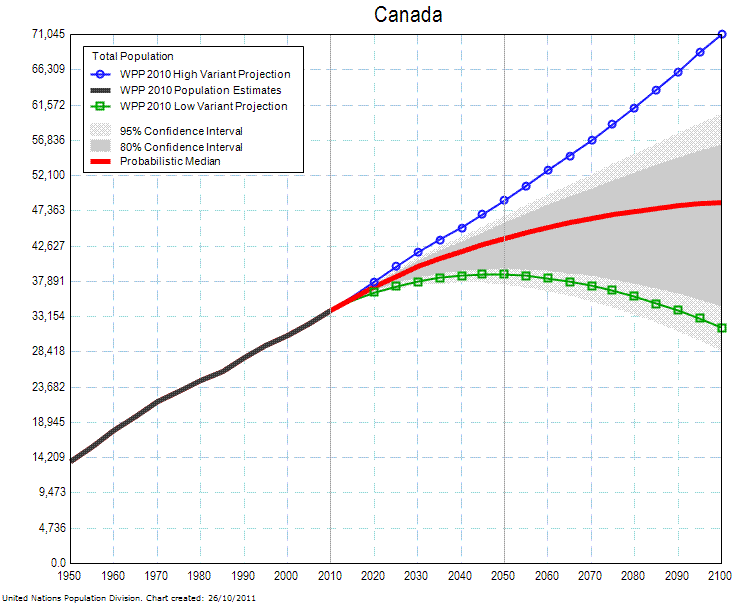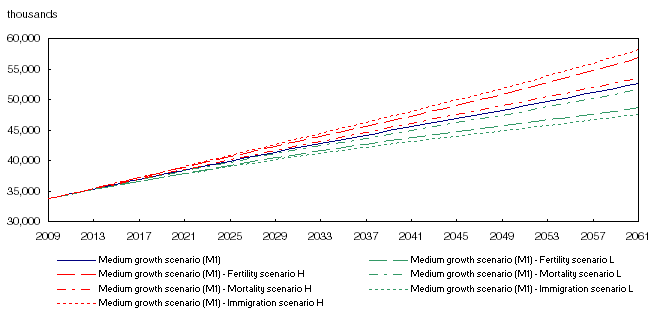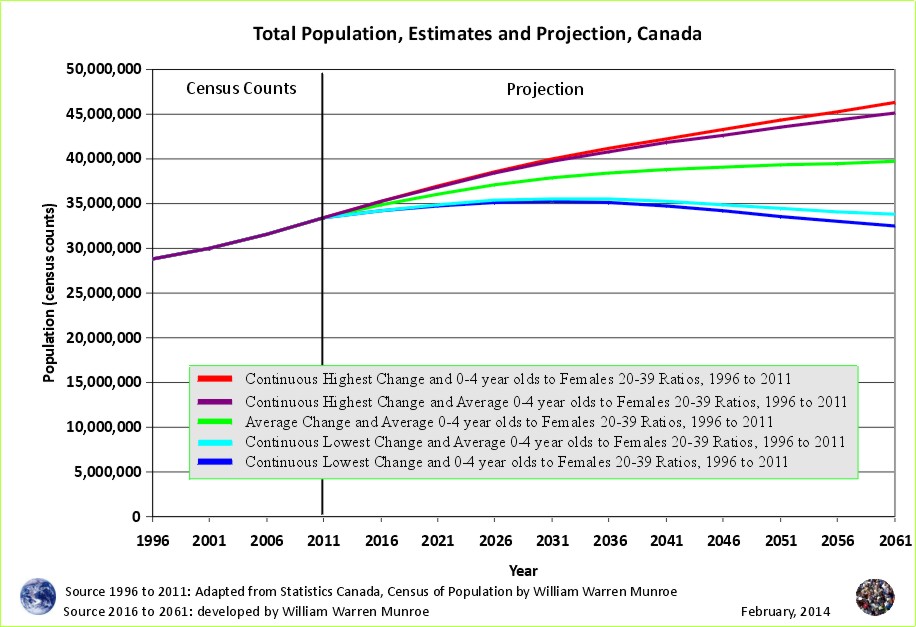This is the first of a four part series looking into the future of population change, globally and locally for the world, Canada, BC, to Canada’s town with the oldest median age, Qualicum Beach.
The purpose is to consider social, economic, and environmental impacts of changing population, from population growth, to stability, and declines.
The following is a comparison of the population projections by United Nations, Statistics Canada, and Warren Munroe’s Population Analysis.

Source: United Nations, Department of Economic and Social Affairs, Population Division (2010): Population projections using probabilistic projections of total fertility and life expectancy at birth, based on a Bayesian Hierarchical Model (BHM). New York (internal data set). See endnote #1.

Source: Population Projections for Canada, Provinces and Territories 2009 to 2036 - Catalogue no. 91-520-X, http://www.statcan.gc.ca/pub/91-520-x/91-520-x2010001-eng.pdf. See endnote #2.

This is a medium scenario developed using the average of the population change seen between 1996, 2001, 2006 and 2011. This method uses "Population Signatures" representing the difference between consecutive census counts, described in this write up.
The High projection is based on the highest ratio of 0 to 4 years relative to the number of females 20 to 39 years of age between 1996 and 2011 censuses. 1996 had the highest ratio. The Low projection is based on the lowest ratio, which occured in 2001.
Source: The 2016 to 2041 projections are created by Warren Munroe (October 2012) with reference to the 1996 to 2011 census counts from Statistics Canada (STC). See endnote #3.
A comparison of the population projections shows similarities between the United Nations and WM Population Analysis
Both these projections suggest the population growth rate for Canada will decline as early as 2030. The decline in the growth rate is due to the rising number of deaths due to ageing, which exceeds births in an increasing number of areas in Canada.
STC's medium scenario suggests Canada's population will increase to over 50 million by 2061, just on the high side of the 95% confidence interval (Figure 1). STC low scenario suggests a population of over 45 million, This projection was developed prior to the 2011 census count release.
The UN medium - "probabilistic mean" - forecasts Canada's population to be approximately 45 million by 2061.
Warren Munroe’s Population Analysis (WMPA) medium scenario, based on changes seen between the census years from 1996 to 2011 (see "Notes to the Reader" below), projects a population of approximately 40 million people by 2061. WMPA's projection fits between the UN's low variant and medium projections, and within the 80% confidence interval.
Since net international migration is the largest contributor to Canada's population increase, a decline in net international migration would lower the projections from these 3 sources.
Endnotes
#1 United Nation Explanation: "These charts show estimates and projections of the total population for 197 countries and areas with a population of 100,000 or more in 2010. The projections are based on the probabilistic fertility projections from the 2010 Revision of the World Population Prospects. These probabilistic projections of total fertility had been carried out with a Bayesian Hierarchical Model. The figures display the high, medium and low variant of the 2010 Revision of the World Population Prospects, as well as the probabilistic median and the 95 as well as 80 percent confidence intervals of the projections. It should be noted that there can be a slight difference between the median of these experimental probabilistic population projections and the medium variant of the official 2010 Revision of the World Population Prospects. This is due to the fact that the population projections displayed here were carried out with a random sub-sample of 5,000 probabilistic fertility trajectories from the original 100,000 trajectories of total fertility used in the 2010 Revision."
See http://esa.un.org/unpd/wpp/P-WPP/htm/PWPP_Total-Population.htm
#2 Statistics Canada Statement "It is also worth noting that the accuracy of any projection is conditional on the reliability of the base population estimates, the component data, and the degree to which the underlying assumptions correspond to future trends. Projections are not predictions; they are instead an effort to create plausible scenarios based on assumptions regarding the components of population growth, which are themselves subject to uncertainty. Accordingly, it cannot be claimed that the values observed in the coming years will always remain within the range implied by the low-growth and high-growth scenarios."
#3 Warren Munroe’s Population Analysis Qualification: The 2016 to 2041 projections are created by Warren Munroe with reference to the 1996 to 2011 census counts from Statistics Canada. Of course the future is open to variation; therefore, projections are still a guess, but at least, with reference to the 1996 to 2011 census counts, this projection can reasonably be considered an educated guess.
While this median scenario is based on the 1996 to 2011 census counts from Statistics Canada, the United Nations and Statistics Canada did not examine, test, review, comment nor contribute to Warren Munroe's projection numbers, 2016 to 2061.
Source: the 1996 to 2011 census counts are from numeric tables from Statistics Canada found online via http://www12.statcan.ca/census-recensement/index-eng.cfm.
NOTE TO THE READER:
The method used to create Figure 3 was developed to project/forecast age sex populations in an effort to meet the needs of people interested in being informed about issues that effect them and their communities.
Therefore, the method has been described in a manner that is meant to be readily understood and easily applied. Remember, calculating population change is arithmetic ... births minus deaths (natural change) plus in-migration minus out-migration (net migration).
See the Service webpage for the write up "Population Projection Package"
In preparation for presentations to Population Specialists (Applied Demographers), a more detailed methods paper is currently being written. Thank yous go out to David A. Swanson, PhD, (University of California, Riverside) for having written "Using cohort change ratios to estimate life expectancy in populations with negligible migration: A new approach" (Swanson and Tedrow, 2012, Canadian Population Society publication) and for sending the methods paper "Forecasting the Population of Census Tracts by Age and Sex: An Example of the Hamilton-Perry Method in Action " (David A. Swanson, Alan Schlottmann, Bob Schmidt 2009).
These and other readings show that variants of the Population Signature method have been used for many years and continues to be refined. Referring to a 2002 report from the UN, Dr. Swansen et al., (2012) state "we prefer to use the more general term "cohort change ratios" (CCRs)." Agreed! The Population Signature charts are simply a graphic representation of the cohort change - the difference between one census aged to compare with the next. The differences by age group are used to calculate ratios that are applied to the latest census age sex counts, to create projections. (November 10, 2012).